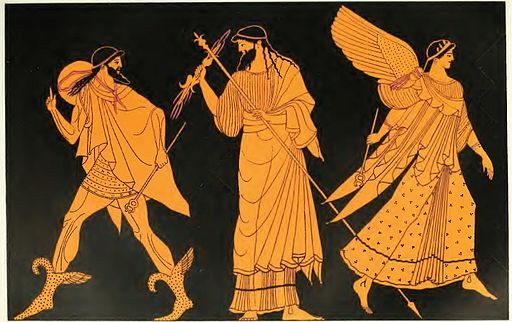Aglaos: Radiant,
Bright, Beautiful, Pleasing.

Gods: Hekate,
Zeus, Hermes
The phrase dates to the Homeric Age, and was in use well
into the early Medieval period. It is found in the Chaldean Oracles as well as
the PGM.
A stele bears the inscription of Zeus Aglaos near the Temple
of Artemis in San Biagio alla Venella, and some of his other epithets have the
same root.
Aglaos Hermes is known from the Homeric Hymn to Hermes,
where he is also called “Dios aglaos huios,” which means Zeus’ Shining Son.
The name of the Grace Aglae has at the root of her name this
same term. It also gives its phrasing to one of the Sirens, various nymphs, and
one epithet for Apollo (Aglaomorphos).
PGM IV 2241-2358 has a long line of epithets describing
Hekate, including Aglaos.
In many of the surviving instances of the word, the term is
associated with festivals and rituals. The word is associated with agalma
(glory, honor, delight), and anything that is agalmata also has the quality of
aglaos.
Aglaos is also the name of several men, including a general
that worked under Ptolemy V.
It was a description given to poets as well, where it implies
great renown. The young are said to have a unique radiance described as aglaos.
As a Homeric term, aglaos is never applied to battle, so the particular type of
renown signified by this epithet is not the same as that gained in war. It is
however given to several warriors in the Iliad, particularly Pandaros.
One man named King Gyges sought the Delphic Oracle to know
who was the happiest man alive, assuming it to be himself, but the response was
that Aglaos of Psophis is happier. Aglaos of Psophis was a poor elderly man who
had lived a good life.
It seems to me that when applied to the Gods it refers to a
literal shining light most often, and an otherworldly beauty. Hekate and Hermes
each carry torches into the darkness of the underworld and through the night.
Zeus is shining in his glory. When given to mortal men, it suggests the health
of the young and the fit, and the radiance that comes from that, as well as the
glow of a life well lived.
One hopes that each of us can attain the beauty and renown
of Aglaos of Psophis, if led by the Radiant Gods.
Sources:
lsj.translatum.gr/
Buraselis, Kostas. Kos
Between Hellenism and Rome: Studies on the Political, Institutional, and Social
History of Kos from Ca. the Middle Second Century BC Until Late Antiquity, vol.
90, part 4. American Philosophical Society, 2000.
Burckhardt, Jacob, et al, eds. The Greeks and Greek Civilization, MacMillan, 1999.
Chaniotis, A. et al, eds. Supplementum epigraphicum graecum, vol. 50, Gieben, 2000.
Day, Joseph W. Archaic
Greek Epigram and Dedication: Representation and Reperformance, Cambridge,
2010.
Foley, John Miles. The
Singer of Tales in Performance. Indiana Univ., 1995.
Fontenrose, Joseph Eddy. The
Delphic Oracle, its Responses and Operations, with a Catalogue of Responses,
Univ. California, 1978.
Gersh, Stephen. Platonism
in Late Antiquity, Notre Dame, 1992.
Horky, Phillip Sidney. Plato’s
Magnesia and Philosophical Polities in Magna Graecia, dissertation offered
to the University of California, 2007.
Mitchell, Lynette and P.J. Rhodes. The Development of the Polis in Archaic Greece, Routledge, 2003.
Meuller, Martin. The
Iliad, A&C, 2013.
Noel, Francois-Joseph-Michel. Dictionnaire historique des personnages célèbres de l’antiquité… avec l’étymologie
et la valeur de leurs noms et surnoms… Nicolle, 1806.
Stansbury-O’Donnell, Mark.
A History of Greek Art, Wiley & Sons, 2015.
Scott, Dominic. Maieusis:
Essays in Ancient Philosophy in Honour of Myles Burnyeat. Oxford, 2007.
Steiner, Deborah. Images
in Mind: Statues in Archaic and Classical Greek Literature and Thought,
Princeton, 2001.
Images:
“Zeus sending forth Hermes and Iris,” red figure, from the Gazette Archéologique: recueil de monuments
pour server à la connaissance & à l’histoire de l’art dans l’antiquité et
le moyen-age, by Francois Lenormant, Paris, 1875.
Leave a comment